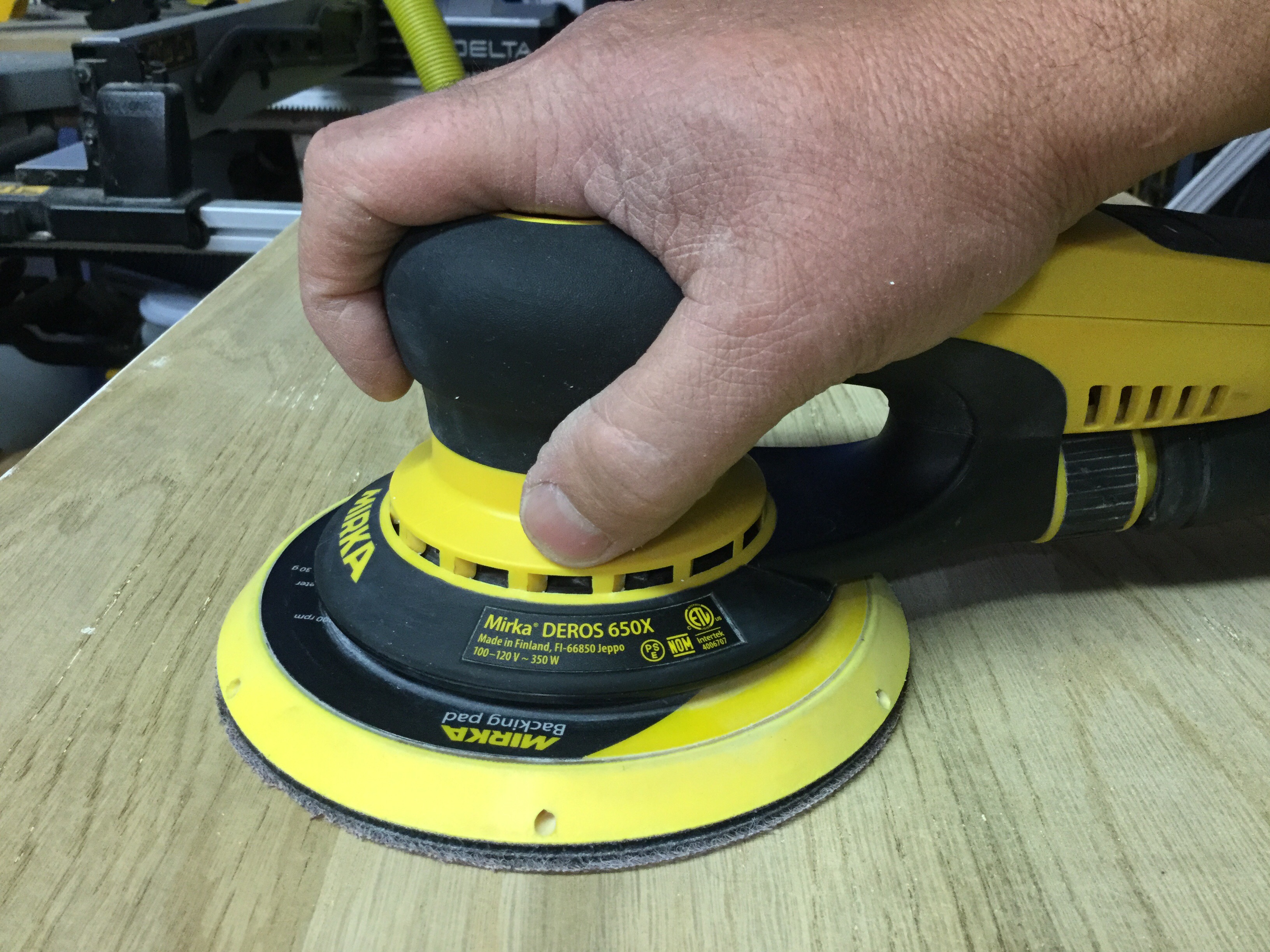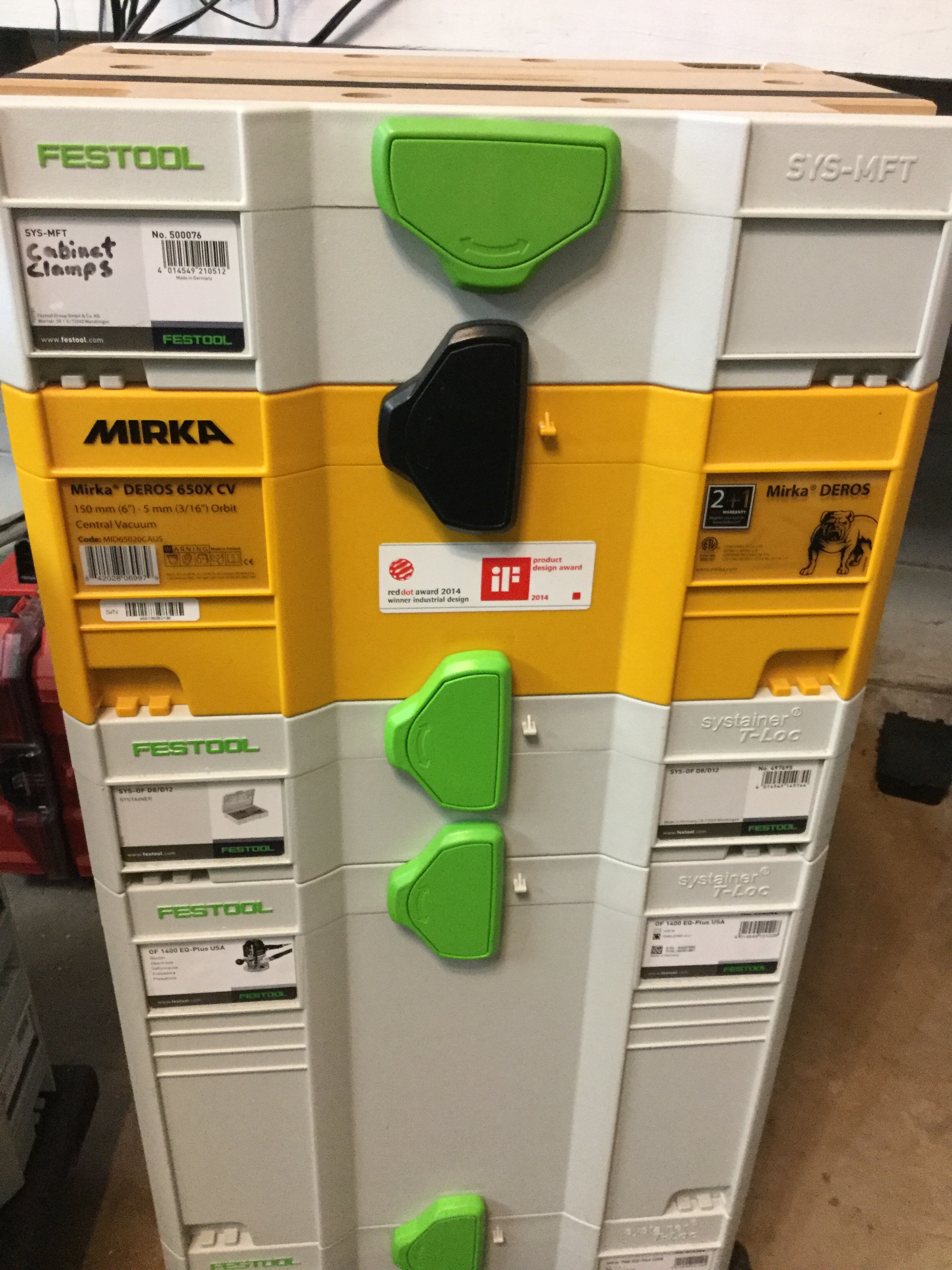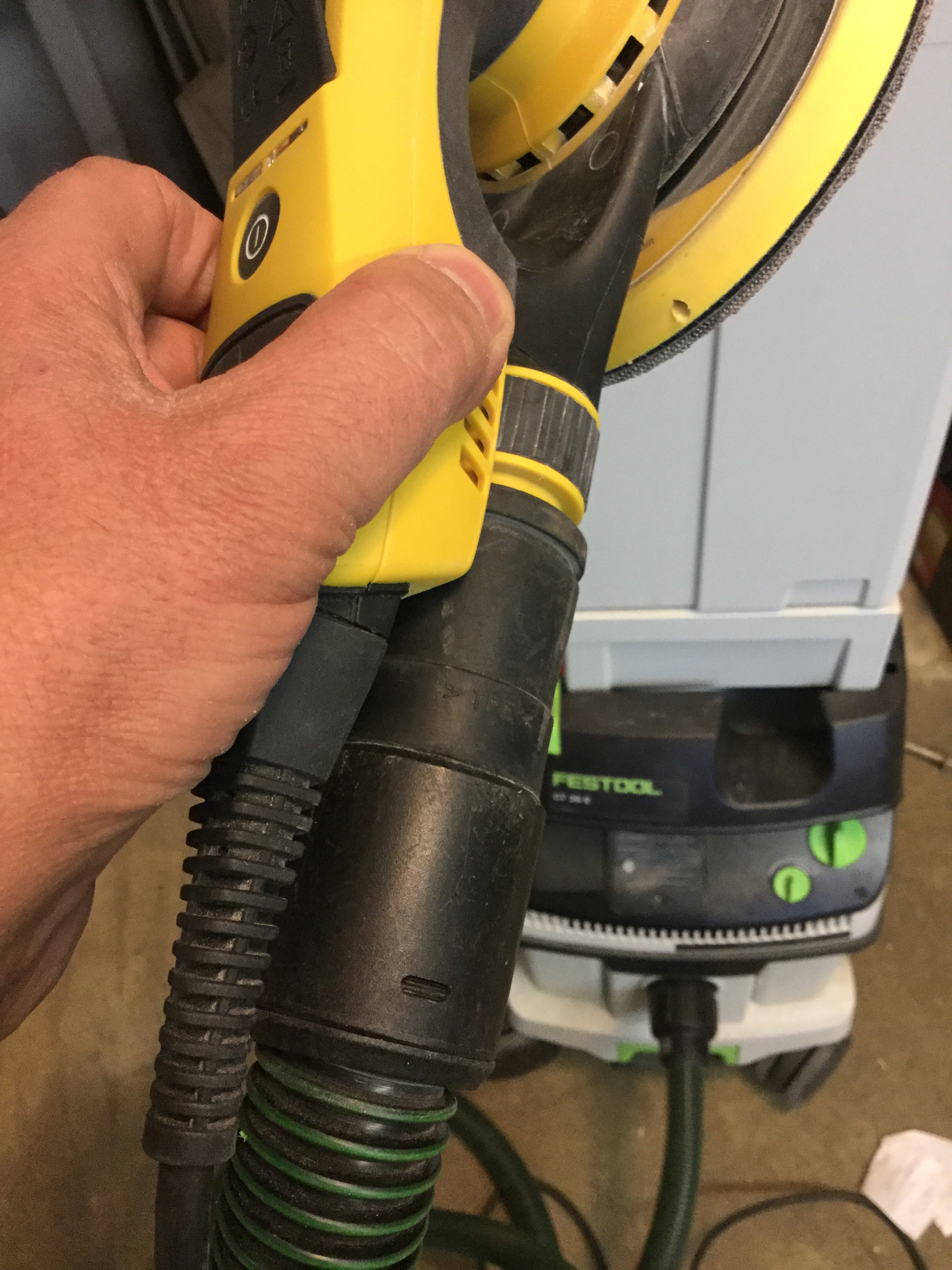Unless you are a master of finely tuned hand planes and cabinet scrapers, chances are you have no choice but to sand. I have met very few people who actually enjoy sanding.
If you think about it, what are the things you dislike about sanding?
#1 It takes too long. This is a very valid point especially if hand sanding but it also fits powered sanders just as well.
#2 It’s too dusty! True with both methods. The very act of sanding abrades small particles from the work surface and these particles are a very fine dust.
#3 It makes your hands numb! Or is at the very least uncomfortable. It doesn’t take long for your fingers and hands to become fatigued when hand sanding or running an orbital. We all know that numb tingly feeling that hangs on long after the sanding has stopped.
#4 It’s noisy! That same vibration from orbital and random orbit sanders that makes your hands numb also causes all sorts of noise. Sometimes it’s loud enough to cause hearing damage.
I have bought and used sanders for many years from nearly every major manufacturer. This includes all of the large mainstream companies. They have all done the job more or less but I can’t say I ever really enjoyed using them. They are the inspiration for the 4 main reasons I didn’t like sanding. Too much of everything. Time, dust, vibration and noise.
A couple of years ago I decided to try something better. I bought my first Festool. The 5″ ETS 125 EQ along with a CT36 dust extractor. This was my first High end sander and I was thoroughly hooked! Even though it is the least expensive sander from Festool, it turned out to be quite a step up. Less noise, less vibration and no dust. One thing that didn’t Change much was the speed. While I did appreciate the infinitely adjustable variable speed, the over all sanding speed wasn’t really faster than a regular sander. The other advantages far outweighed speed though. Overall In the sub 200.00 group, this was by far my top pick. It opened my eyes up to a whole universe of better tools. I had to see what else was out there.
I kept finding myself looking at the Mirka sanders from Finland. I had heard about how much better they were. When I finally decided to try one, I had to decide between the Ceros and the Deros. Both are brushless. Both are compact. Both are smooth. Both are very powerful. Both are nearly 100% dustless. The Ceros has been on the market longer. It is very unique in the power tool world in that it runs on DC power. This means that it comes with a large transformer. This is somewhat of a disadvantage but it’s also an advantage. You can purchase a 6″ sander kit and add on a 5″ or a 3″ for a fraction of the cost. Ultimately though I decided to go with the Deros. ( Direct Electric Random Orbital Sander ) I ordered the 6″ version with the 5mm orbit. There are also 2.5mm and 8mm versions for finer or more aggressive sanding. I also ordered several grits of Mirka’s Abranet abrasive. Abranet (abrasive net) is very nice to use. Instead of a paper sheet with punched holes for dust collection, it is made up almost entirely of holes. This allows for supreme dust collection. The Deros is as dust free as it gets. This feature of the abrasive keeps it cleaner and allows the abrasive to work longer without clogging. It also allows it to run cooler when sanding paint to reduce melting of the paint and clogging.
When it arrived I loved how the yellow T-Loc systainer fit right in with my other Systainers from Festool and other companies. The first time I opened it up, I couldn’t beleive my eyes! The Deros was tiny! It looked just like a sander, only smaller but with a huge pad. It is only 3.75 inches tall and weighs 2.2 lbs! I picked it up and just had to wrap my head around the fact that it was so light. It was the most compact sander I had ever seen. The systainer includes a molded organizer to hold the tool and accessories. The lid has a nice foam block installed to hold the sander firmly in its molded spot. There was also A hook and loop pad saver for use with Abranet discs, a few sample sheets of abrasive, a wrench, the manuals and a DVD about the Deros.
I unrolled the extra long removeable and interchangeable 4m cord and plugged it in to my Festool CT36. I was pleasantly surprised that my 27mm Festool hose fit perfectly in both diameter and length! I had read that the Mirka sanders did not fit. That must have been an issue with the Ceros. The dust port on The sander has a nice swivel future to help avoid hose tangling.
I put the hook and loop pad saver on as well as a 120 grit disc , pushed the power button and played with the variable speed buttons and the variable paddle switch. Thats right, it has + and – buttons rather than a dial to adjust the maximum speed between 4000 RPM and 10,000 RPM. The paddle switch is set up similar to the high-end air sanders where the harder you push on the paddle switch the higher the speed. When I pushed the paddle and started sanding, my jaw dropped and my head bobbed forward. This tiny thing has got to have the highest power to weight ratio of any sander on the market. There was no awkward learning curve. It immediately felt like an extension of my hand. The center of gravity was extremely low and stable. The power and speed was unreal! It was exactly what I had always wished for. I found I could push much harder on the Mirka without stalling the pad compared to any sander I had used previously. In fact it is extremely hard to bog it down with one hand. My wrist could not handle pushing that hard on the sander all the time but it is very nice to know that if I need to push harder on a certain spot that the sander will power through without stalling out and creating unsightly swirl marks. Check out the video on YouTube >>> https://youtu.be/NmVZHIa1btE
Another advantage I noticed right away was how quiet the Deros was compared to my other Sanders. The sound is so different. It’s so authoritative and beefy sounding but at a lower level than I was used to. When you turn it down, it can become just a whisper.
As a fire , water and mold damage restoration and remodeling contractor, I have used the Deros on many types of sanding tasks. Sanding raw wood. Painted wood, metal, painted walls, new drywall, old popcorn ceilings, knockdown drywall texture before and during repairs, cabinet builds , cabinet refinishing and furniture restoration. In each and every situation, I was nothing but impressed with the performance. In every case it has been faster, smoother, quieter and more powerful all with near zero dust.

With a sander like the Deros, downdraft tables and large dust collectors are completely unnecessary. In fact you don’t even need a very powerful dust extractor to realize the benefits of its superior dust collection. I find that I never need to run my Festool CT36 variable speed vacuum on high with it. I usually run it at 1/2 power or less. The Deros is so powerful that the suction from any vac on high will not affect the pad speed. But there is the extra noise factor so I always dial it down. (With regular sanders, running the dust extractor on lower power levels can actually help with making a better finish at times. Excessive suction can actually slow the pad down too much, creating more chance of swirl marks.)
So when does it make sense to pay this much for an electric sander? Any time a person makes their living doing woodworking, cabinet building or finish carpentry it makes sense to use higher quality tools. In cabinet shops you often see pneumatic sanders. While these are very powerful they cost a lot to operate. The tool itself may not be any more expensive than the Deros but the air supply system is extremely expensive. The pneumatic Sanders require incredible amounts of clean dry air. The air compressors , air line dryers / water separators all add up to thousands of dollars of additional cost not to mention the electricity necessary to run a large air compressor. Even though this sander may seem expensive it is a real bargain when compared to the pneumatic alternatives used in cabinet shops.
In addition to high volume cabinet shops, who else is buying the Mirka Deros? I have done a little research because I wondered myself. What I found was that the sander is used across the board in many industries that involve sanding. Auto body repair shops, drywall contractors, woodworkers, painting companies, high end furniture builders, flooring companies, remodeling contractors, boat repair shops, boat builders, surfboard manufacturers and the list keeps growing. Basically any one who wants the very best performance from a handheld sander.
Whether or not this award winning sander makes sense for you can only be determined by you personally. For me it is a no-brainer. If my Deros was missing tomorrow I would order one to replace it immediately. The benefits that I see every time I use it for outweigh the cost. The smoothness of its operation, the low noise output, the high power output and The supreme dust collection all make the Mirka Deros the most advanced and user friendly sander on the market today.





I’ve been using the Mirka DEROS for about two years now, and it’s easily one of the quickest sanders I’ve ever used. It’s very efficient and really helps to speed up the sanding process. Overall, I’m very happy with the performance of this sander. Besides, you have describe the worth is so clearly. It is really great to be able to have this information.
Has anyone had any trouble with their Mirka Deros completely quit working. We have four Mirka Deros 650Cv Sanders and we have had to send all four back at some point in the last two years. They are great with replacing them, we have yet to pay for any parts or labor. They even gave us a few brand new sanders when the ones we sent back were too far gone. I just don’t have the time to send them a sander back every few months, and go through all the paperwork. If anyone has had similar problems and figured out why please let me know. Thanks!
This is hard to choose with is a better sander …Frestool Rotex 150 vs Mirka Deros 5650 …sounds like the Mirka may over heat but sands or has a better feel plus you get a 5 and a 6 inch head. have not heard any one say the Rotex overheats….I am just looking for an all around good reliable sander…..the money for both are close in price ….sounds like you have uses both so any advice would be great….
I have never heard of Mirka before and I just bought the Festool rotex 150, but now after reading I am thinking of returning it for maybe the Mirka ….not sure why Festool did not make changeable heads for the rotex…..It would make it a great tool but they are more concerned about making money….very smart that Mirka did, more bang for the bucks if it a better sander, again over heating may be it’s problem.
There is no universal , simple advise on whether Mirka or Festool Rotex to buy. It all depends on many factors like how intense , frequent and demanding the use of the sander is, the size and roughness of the wood surfaces you work on, the environment ( ambient temperature and the dust extraction air flow ), the type of wood, etc. Mirka is very elegant, light , more ergonomic tool. Fetool ROTEX is heavier, less sensitive to overheating due to larger body but more tiring for the user.
After having learned this lesson Iam happy with both of them and use them accordingly to the above considerations.
I commented on Mirka DEROS vulnerability when used in heavy duty environment (sanding rough oak hot summer , unshaded place) . The comment was published on 03._rd of August, I think.
Then the broken down Mirka was taken to the authorized service station in Budapest. They fixed it and the sander works fine . However I had to conclude the learning points from the case. Mirka Deros is a tiny, sophisticated, minimum-mass construction to prevent fatique of our hand. That obviously makes the heat dissipation constrained in higher ambient temperatures. Actually I worked it in the sun with temperature well exceeding 30 deg C. The hot “cooling air” stream just could not coup with the heat release. Recent summer days often produce hours with temperatures over 40 deg C, too.
Since this experience I use this sander in less demanding applications with pleasure. The Mirka is a thoroughbred racehorse but not a draft horse.
I use it in my workshop where air condition is provided.
I hope this additional comment may encourage fellow woodworkers turning to Mirka DEROS . Just keep it from overheating and enjoy the perfect finish it gives you.
I recently upgraded to the Deros for my cabinet shop. It makes sanding fun. Need I say more.
I am a hobby woodworker and have been using a lot of different sanders in the past almost 30 years. This article is very useful by pointing out the characteristics and the adventages of Mirka Deros if compared to some other makes.
May I add some factual remarks to further sharpen the picture with some less favorable point ?
I have used my Mirka Deros for less than 20 hours altogether for different minor projects along with the older sanders from my shop as the Festool Rotex RO 150 FEQplus, the Makita 9046 and Hilti WFE 450, etc.
The Mirka became my favorit for its nice features desribed by its features treated above.
A few days ago I was sanding an oak table outside in the yard in the shade where the temperature measured some 27-28 deg C (ca 82 deg F). The dust was collected by a Hitachi RP35YE providing substantial cooling to the body of the Mirka, I presumed.
After some 30 minutes the Mirka became overheated and stopped.
I had to finish the job using the good old ( heavier, clumsier but far more reliable ) Makita 9046…
The Mirka was taken to the repair shop and now I have been waiting for the news on what can be done with it.
The Mirka Op Man says that the thermal switch slowes and stops the sander in order to prevent the overheating. I testify that it happens even at lower ambient temperatures as the 28 degC but whoever wants to work on a more permanent basis shall think twice before cashing out on Mirka. I wish I had not been mesmerised by the beauty of this little thing and had the money for a real sander…
Tony Katona from Hungary
I’m sorry, I meant the Ray system as the Trident is the pneumatic version. It is brushless and power source on board instead of separate.
Thanks for all you do in this community! Have you heard of the Surfprep sanding system? I have one of their 3 by 4 finish prep sanders and am wondering how their Trident 5″ setup stacks against deros and ro150. Thanks!
I have not used them so I can’t comment.
Sure thing, thanks man!
Is their anything close to comparable in the festool lineup? Or are the differences that great?
The ETS-EC sanders are the closest thing from any company. They are less $$$ as well. Can you beleive that? Festool is le$$??
Do you prefer these sanders to Rotex Paul?
Yes I do. Rotex is definitely more powerful but these are close and so much smoother and controlled. Also the Deros is so quiet by comparison??
Wow! Learn something new everyday I guess, might need to divert some of the tool budget to a premium sander piggy bank lol.
This is an informative read, I appreciate reading this since it’s hard to know if these tools are worth it.
Do you know what the differences are between the different models: 5650cv, 625cv, 650cv, and 550cv?
Great article! This and your insta posts about it sold me on this.
Yes sir Devin. Thanks for the feedback! The numbers are for the different models according to size of pad and orbit. The motor is the same on all of the models. The 650cv is 6″ pad with 5mm orbit. The 625cv is 6″ pad with 2.5mm orbit for a finer finish which is hard to believe possible. Same with the 550 and 525. Now. The 5650cv is 2 sander’s in one with Both the 5″ and 6″ pads. It was not available in the US when I bought mine. The 5″ pad with the proper weighting is now available here separatly! I need to order one. I really should add a paragraph to my review about the new pad.